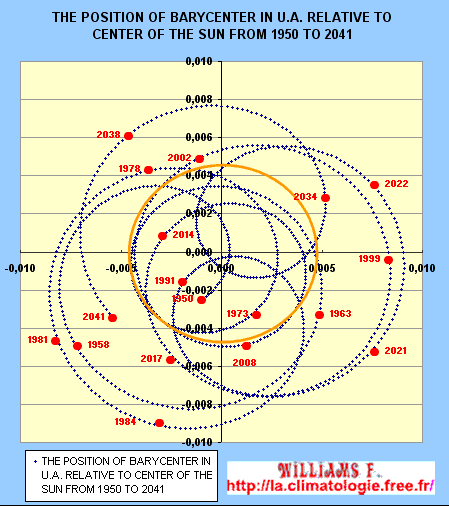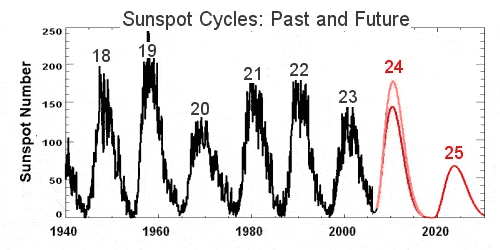2st PART
These variations in the Sun's activity are linked to cycles of irregular oscillation of the center of mass of the solar system, it's the gravity center of the solar system. But the movement of the Sun around the center of mass of the solar system is quite complicated as its layout is changed by varying the position of the giant planets (Jupiter, Saturn, Uranus and Neptune) especially Jupiter. The orbital cycles of our star vary from 15 to 23 years during which the sun is alternately accelerated and braked. The different orbits of the gravity center of the sun around barycenter of the solar system recur sequentially with a period of 179,60 years.
This diagram
shows the irregular oscillation of the Sun around the center
of
The distance between the Sun and the center of gravity of the Solar System depends on the position of the planets and Jupiter mainly the most massive planet in the Solar System. When the four Jovian planets, the four largest
planets in the Solar System, are aligned on the same side
of the Sun, then about balance the center of the barycenter
is at the farthest distance from the Sun is about 1,13 solar
radii ie 789.467,48 km of the
Sun's surface or around 1.485.097,58
km from the center of Sun. When Saturn, Uranus and Neptune are aligned
on the same side of the Sun and Jupiter is opposite the Sun
then the gravitational mass and the distance of Jupiter from
the Sun closer than the other three Jovian planets do that
the barycenter is at the minimum distance from the center
of the Sun. So the center of gravity is at 627.371,96
kilometers below the surface of the Sun is at 68.258,14
km from the center of the Sun.
Barycenter position Jupiter takes 11,90 years to complete one revolution of its orbit and Saturn 29,50 years. These two planets have a cycle of 19,86 years of their conjunctions (Sun-Jupiter-Saturn) to the next through an opposition (Sun-Jupiter-Saturn) after the first conjunction of 9,93 years. This cycle is very close to the double of the Schwabe solar cycle of 8-13 years ie that of Hales cycle of 22 years. The other two jovians planets (Uranus and Neptune) could be the cause of the variation in the duration of these two cycles. The Sun has a differential rotation on itself because of its outer layers that do not rotate as a solid body : while its surface makes a revolution every 25,40 days at the equator, it must not less than 36 days at the poles . This rotation is responsible for the activity. By turning on itself it creates a magnetic field 5.000 times stronger than that of the Earth. Solar energy is created deep within the core of the Sun. This is where the temperature (15.000.000°C or 27.000.032°F) and pressure (340 billion times Earth's pressure at sea level) is so intense that nuclear reactions take place. These reactions cause the fusion of four protons (hydrogen nuclei) to form an alpha particle (helium nuclei).
The disruption of convection currents due to planets, would affect the solar activity because more the convection currents are slow, lower is the solar activity and the faster they are, more important is solar activity. According to the theory and observation of convection currents, their speed allow to forcast the intensity of solar activity of about the next 20 years. The slowdown that we saw before the solar cycle No. 24 has been able to show that this solar cycle would be much lower than the cycle No. 23 and then the solar cycle No. 25 that should be at maximum around the year 2025 ± 1 could be one of the lowest in recent centuries according the violation of the G.O. law.
The Forecasting of the solar cycle No.
24 and 25 according to NASA
(end of 2006). Until If we compare the change in the anomaly of the Northern Hemisphere temperature with the change in the time between the maximum distance Sun-barycenter to the following during the next removal between the Sun and the barycenter we see that for the past 1000 years they follow themselves very well. Only the last ten years the temperature follows less well due to the greenhouse effect which has also increased the temperature in the last 30 years because of the effect of man and therefore his influence has disrupted the climate which was not the case in previous centuries.
Comparison between the variation in
temperature anomaly in the northern hemisphere See next page for remainder Causes of Solar Cycles WARNING |








